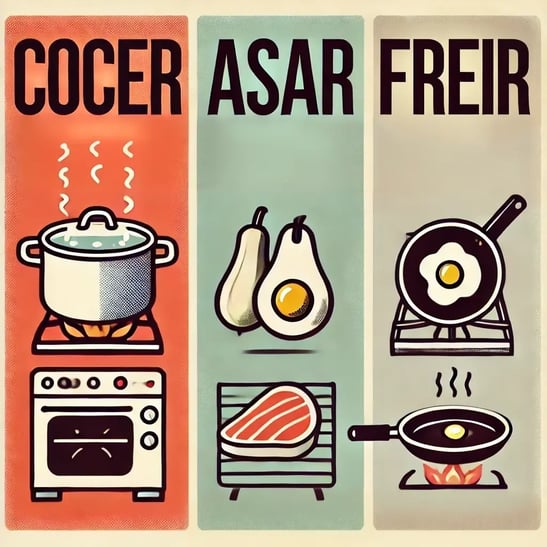Cooking is a daily activity that can help you improve your Spanish in a practical and fun way. In this article, you will learn how to say 'to cook' in Spanish, discover essential cooking verbs and utensils, understand how to follow a recipe, and finally, share your signature dish. Let's cook in Spanish! 🍳
.gif?width=616&height=322&name=Imagen%20-%20Post%20-%203%20best%20ways%20(14).gif)
🍳 How do you say 'to cook' in Spanish?
The verb 'cocinar' (to cook) is the equivalent of "to cook" in English. Depending on the context, you can also use:
'Cocer' (to boil), e.g., 'cocer pasta' (to boil pasta).
'Asar' (to roast or grill), e.g., 'asar pollo' (to roast chicken).
'Freír' (to fry), e.g., 'freír patatas' (to fry potatoes).

✅ Essential cooking verbs in Spanish
To follow a recipe in Spanish, it is important to know some key verbs:
🍏 'Pelar' (to peel): To remove the skin from fruit or vegetables. 🍏
🔪 'Picar' (to chop): To cut into small pieces.
🥚 'Batir' (to whisk): To mix quickly.
🥄 'Mezclar' (to mix): To combine ingredients.
♨️ 'Hervir' (to boil): To cook in boiling water.
🍞 'Hornear' (to bake): To cook in the oven.
🍳 'Sofreír' (to sauté): To fry over low heat.
🌿 'Aliñar' (to season): To add condiments or spices.
♨️ Essential kitchen utensils in Spanish
'Cuchillo de chef' (Chef’s knife): Used for cutting, chopping, and slicing.
'Cuchillo para pelar' (Paring knife): Small and precise, ideal for fruits and vegetables.
'Tabla de cortar' (Cutting board): A surface for cutting without damaging the countertop.
'Rallador' (Grater): Used to grate cheese, vegetables, or spices.
'Pelador' (Peeler): Used to remove the skin from fruits and vegetables.
🔥 Utensils for cooking:
'Sartén' (Frying pan): Ideal for frying, sautéing, and browning food.
'Olla' (Pot): Used for boiling, slow cooking, and preparing broths or soups.
'Cazo' (Saucepan): Smaller than a pot, useful for sauces and heating liquids.
'Horno' (Oven): Used for baking bread, cakes, meat, and vegetables.
'Vaporera' (Steamer): Used to cook food healthily by steaming.
📓 Common expressions in recipes
Spanish recipes often include certain recurring terms and expressions that are useful to know:
🧂 'Una pizca de...' (A pinch of...): Used to indicate small amounts of spices or condiments.
♨️ 'A fuego lento' (On low heat): Indicates that the cooking should be done at a low and constant temperature.
🔥 'A fuego medio' (On medium heat): Cook at an intermediate temperature.
🔥🔥 'A fuego alto' (On high heat): Indicates that cooking should be done at a high temperature.
🧂 'Salpimentar' (To season with salt and pepper): Add salt and pepper to taste.
🍞 'Enharinar' (To flour): Coat food with flour before frying or cooking.
🍷 'Macerar' (To marinate): Let food rest in a liquid to absorb flavour.
🥖 'Dorarse' (To brown): Cook until the surface of the food turns golden brown.
🍰 'Montar claras a punto de nieve' (To whip egg whites to stiff peaks): Beat egg whites until they become firm and fluffy.
📋 Sentence structures and verb tenses in a recipe
Spanish recipes use a combination of verb tenses and specific structures to give instructions clearly and precisely. Some of the most common tenses are:
🫵 Imperative tense: Used to give orders or direct instructions.
Example: 'Pela las patatas y córtalas en trozos pequeños' (Peel the potatoes and cut them into small pieces) 🔪
👇 Present tense: Used to describe the general process of a recipe.
Example: 'Se añade el azúcar y se mezcla bien' (The sugar is added and mixed well) 🍰
👈 Present perfect: Sometimes used to indicate a completed action.
Example: 'Una vez que has mezclado los ingredientes, viértelos en el molde' (Once you have mixed the ingredients, pour them into the mould) 🥄
👉 Future simple: In some recipes, it is used to indicate the result of a step.
Example: 'Después de 20 minutos, el bizcocho estará dorado' (After 20 minutes, the cake will be golden brown) ⏳
It is also common to see passive structures such as:
'Se' + verb: 'Se corta la cebolla en rodajas' (The onion is cut into slices).
Use of connectors to structure the steps: 'Primero' (First), 'A continuación' (Next), 'Después' (Then), 'Por último' (Finally).
👩🍳 Our recipes in Spanish
Carpaccio de higos - Fig Carpaccio
Berenjenas glaseadas - Glazed aubergine
Bizcocho esponjoso - Sponge cake
Tortilla de patatas española - Spanish potato omelette
⭐ Share your signature recipe!
Now that you know the verbs and kitchen utensils, we invite you to share your signature recipe in Spanish. It can be a traditional dish from your country or a recipe you have created. Tell us the ingredients and steps, and let's learn to cook in Spanish together!
Keep learning Spanish:
-
March 5, 2025
🤓 What does 'como' mean in Spanish? A fun guide for learners 🇪🇸✨
Read more🎉 Why is como so confusing?
If you've started learning Spanish, you've probably noticed that como, cómo, and comer look dangerously similar. But...
-
March 5, 2025
🔁 Again in Spanish: The complete guide - Meaning, uses, examples & real alternatives
Read moreIf you’re learning Spanish, you will need the word again constantly. Whether you're asking someone to repeat something, fixing a mistake, expressing...
-
March 5, 2025
🌅 East in Spanish: Cardinal points and how to talk about locations in Spanish
Read moreIf you want to sound confident when travelling around Spain 🇪🇸, asking for directions 🧭, describing where cities and countries are 🌍 or simply...
-
March 5, 2025
🌸 Things to do in Seville, Spain: Stunning spots you can’t miss ☀️
Read moreIf you’re searching for things to do in Seville Spain, get ready — this city is pure magic ✨. From flamenco to Moorish palaces, stunning viewpoints...
Ready to cook and learn Spanish at the same time? Let's go! 👩🍳👨🍳
Share your signature recipe!
-3.gif?width=419&height=258&name=GIF%20(1)-3.gif)


-1.jpg)
.png)
.png)
-Nov-19-2025-10-19-48-2650-AM.jpg)
